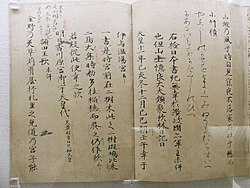“Sisam itak” のwerson間の差分
(リンクをつけました) |
(Infobox housi) |
||
| 1行目: | 1行目: | ||
{{Infobox Language|name={{big|{{ruby-ja|日|に}}}}{{big|{{ruby-ja|本|ほん}}}}{{big|{{ruby-ja|語|ご}}}}|image=[[ファイル:Genryaku Manyosyu.JPG|250ピクセル]]<br>{{center|元暦校本[[万葉集]]}}<br>[[File:Nihongo.svg|60px|[[日本語の表記体系]]に沿って'''日本語'''という語を記した例]]|imagecaption=[[日本語の表記体系]]に沿って'''日本語'''という語を記した例|imagesize=80px|pronunciation=<br />{{IPA|nʲiho̞ŋːo̞}}<ref>[[日本国語大辞典]]([[小学館]])の日本語の項によれば、「ニホンゴ」</ref><br />{{IPA|nʲiho̞ŋɡo̞}}<ref name="asahi20150305"> | |||
{{Cite news|url=https://www.asahi.com/articles/ASH2W5751H2WUCVL00X.html|title=「鼻濁音」来世紀ほぼ消滅? もともと使わない地域も…|newspaper=[[朝日新聞デジタル]]|publisher=[[朝日新聞社]]|date=2015-03-05|archiveurl=https://web.archive.org/web/20150305002557/https://www.asahi.com/articles/ASH2W5751H2WUCVL00X.html|archivedate=2015-03-05}}</ref><br />{{IPA|nʲip̚po̞ŋːo̞}}(まれ)<ref>[[日本国語大辞典]]([[小学館]])の日本語の項によれば「ニッポンゴ」。</ref><br />{{IPA|nʲip̚po̞ŋɡo̞}}(まれ)<ref name="asahi20150305" />|familycolor=Altaic|states={{JPN}}|region={{PLW}}[[アンガウル州]]|ethnicity=[[日本人]]([[大和民族]]、[[アイヌ]]、[[琉球民族]]を含む)|speakers=約1億2,500万人<ref>"Världens 100 största språk 2010" (The World's 100 Largest Languages in 2010), in Nationalencyklopedin</ref><br />または<br />約1億2,700万人{{Efn|[[琉球諸語]]を[[方言]]とみなし、数に含んだ場合で、[[国勢調査 (日本)|国勢調査]]を基にした場合の[[概数]]。}}|family=[[日琉語族]]([[孤立した言語]]で論争あり。詳細は[[日本語の起源]]を参照。)|ancestor=[[上代日本語]]|ancestor2=[[中古日本語]]|ancestor3=[[中世日本語]]|ancestor4=[[近世日本語]]|dialects=[[日本語の方言]]|stand1=[[標準語#各言語における標準語|標準語]]|script=[[仮名 (文字)|仮名]]([[平仮名|{{ruby-ja|平仮名|ひらがな}}]]・[[片仮名|{{ruby-ja|片仮名|カタカナ}}]])<br /> [[日本における漢字|漢字]]<br />[[点字]]|nation={{JPN}}(事実上)<br />{{PLW}}{{Efn| | |||
* 1982年の''"パラオ共和国 アンガウル州憲法"'' によれば、パラオ共和国 [[アンガウル州]]の公用語は、[[パラオ語]]・英語・日本語である<ref name="const">{{cite web|url=https://web.archive.org/web/20140808040100/http://www.pacificdigitallibrary.org/cgi-bin/pdl?e=d-000off-pdl--00-2--0--010-TE--4-------0-1l--10en-50---20-text-Japanese--00-3-1-00bySR-0-0-000utfZz-8-00&d=HASHa4b7077d472c4cdb9c8ddf.10&p=text|title=Constitution of the State of Angaur|publisher=Pacific Digital Library|access-date=15 March 2021|quote=The traditional Palauan language, particularly the dialect spoken by the people of Angaur State, shall be the language of the State of Angaur. Palauan, English and Japanese shall be the official languages.|at=Article XII}}</ref>。 | |||
* 日本国は「日本語」を{{u|事実上の公用語}}としているため、日本語を正式に公用語としている国は世界で唯一「パラオ共和国 (アンガウル州) 」のみとなる。 | |||
* しかし、2005年のパラオ共和国の国勢調査の結果、2005年4月現在「自宅で日本語を話す、5歳以上のアンガウル州の居住者、および法定居住者」はいなかったと報告されている<ref name="2005census">{{cite web|url=https://web.archive.org/web/20140424211256if_/http://palaugov.org/wp-content/uploads/2013/10/2005-Census-of-Population-Housing.pdf|title=2005 Census of Population & Housing|publisher=Bureau of Budget & Planning|access-date=15 March 2021}}</ref>。 | |||
* また、自身が日本ないしは日本の民族的出身であると報告した人もいなかった<ref name="2005censusfr">{{cite web|url=https://web.archive.org/web/20140811163937if_/http://palaugov.org/wp-content/uploads/2013/10/2005-Census-Monograph-Final-Report.pdf |title=2005 Census Monograph Final Report |publisher=Bureau of Budget & Planning |access-date=15 March 2021}}</ref>。 | |||
* アンガウル州で生まれたある一人の人物は、自宅で日本語とパラオ語を同じくらい頻繁に話すと語ったが、アンガウル州には居住していないものとみられる<ref name="2005census" />。 | |||
* 2012年のパラオ共和国の簡単な国勢調査では、アンガウル州の総人口130人のうち「パラオ語と英語以外の言語」で読み書きができる、10歳以上の居住者は、7人いることが報告された<ref name="2013syb">{{cite web|title=2013 ROP Statistical Yearbook|url=https://web.archive.org/web/20140811163907if_/http://palaugov.org/wp-content/uploads/2014/07/2013-ROP-Statistical-Yearbook.pdf|access-date=15 March 2021|publisher=Bureau of Budget & Planning}}</ref>。 | |||
}}|agency={{flagicon|JPN}} [[文化庁]] [[文化審議会]] [https://www.bunka.go.jp/seisaku/bunkashingikai/kokugo/ 国語分科会](事実上)|iso1=[https://www.loc.gov/standards/iso639-2/php/langcodes_name.php?iso_639_1=ja ja]|iso2=jpn|iso3=jpn|lingua=45-CAA-a|glotto=nucl1643|glottoname=<br />([[八丈方言]]を除く)|glottorefname=Japanese|map=|notice=IPA}} | |||
Sisam itak (日本語, Nihongo, [ɲihoŋɡo]) anak cupkaun [[Asia]] or ta an [[Nihon]] or ta a=ye [[itak]] ne. Sisam itak [[Niciriu itakutar|Niciriw itakutar]] onrak. | Sisam itak (日本語, Nihongo, [ɲihoŋɡo]) anak cupkaun [[Asia]] or ta an [[Nihon]] or ta a=ye [[itak]] ne. Sisam itak [[Niciriu itakutar|Niciriw itakutar]] onrak. | ||
2024 ppm 3 2024-03-04T13:43:06+00:00up 4 312024 (Kun.) 13:43時点におけるwerson
 元暦校本万葉集  日本語の表記体系に沿って日本語という語を記した例 | |||||||||||||||
| Hawhum |
IPA: [nʲiho̞ŋːo̞][1] [nʲiho̞ŋɡo̞][2] [nʲip̚po̞ŋːo̞](まれ)[3] [nʲip̚po̞ŋɡo̞](まれ)[2] | ||||||||||||||
| Mosir |
| ||||||||||||||
| Sisserke | Nokaor:PLWアンガウル州 | ||||||||||||||
| 民族 | 日本人(大和民族、アイヌ、琉球民族を含む) | ||||||||||||||
| Itakkur |
約1億2,500万人[4] または 約1億2,700万人[注釈 1] | ||||||||||||||
| Ikir | |||||||||||||||
| 初期形式 | |||||||||||||||
| 標準語 | |||||||||||||||
| Iposse | 日本語の方言 | ||||||||||||||
| Itakitokpa |
仮名( 漢字 点字 | ||||||||||||||
| 公的地位 | |||||||||||||||
| 公用語 |
Nokaor:PLW[注釈 2] | ||||||||||||||
| 統制機関 |
| ||||||||||||||
| Itak Iuscipiskip | |||||||||||||||
| ISO 639-1 |
ja | ||||||||||||||
| ISO 639-2 |
Nokaor:ISO 639-2 | ||||||||||||||
| ISO 639-3 |
jpn | ||||||||||||||
| Glottolog |
Hammarström, Harald; Forkel, Robert; Haspelmath, Martin et al., eds (2016). “Sisam itak”. Glottolog 2.7. Jena: Max Planck Institute for the Science of Human History (八丈方言を除く)[9] | ||||||||||||||
| Linguasphere |
45-CAA-a | ||||||||||||||
| |||||||||||||||
Sisam itak (日本語, Nihongo, [ɲihoŋɡo]) anak cupkaun Asia or ta an Nihon or ta a=ye itak ne. Sisam itak Niciriw itakutar onrak.
Sisam itak hiragana, katakana, kanji yak a=ye re itakitokpa a=eywanke. Hiragana, katakana haw yaysankere itakitokpa ne hine kanji itaknum yaysankere itakitokpa ne.
Hawhum
Sisam itak anak arwan ununehum kor. Arwan ununehum tanneru ani iumosmanukar=an.
| sa | noski | mak | |
|---|---|---|---|
| hutne | i | ɯ | |
| noski | e | o | |
| sep | a |
Ponehum anak sisak re ponehum a=omare wa tupesanpe ikasma wanpe oka.
| urenpatoy | nirus | nitnenikotor | hapurnikotor | rekut | |
|---|---|---|---|---|---|
| etu | m | n | |||
| pus | p b | t d | k g | ||
| pussiru | t͡s | ||||
| siru | s z | h | |||
| toptukan | r | ||||
| hanke | w | j | |||
| sisak mora | /N/, /Q/, /R/ | ||||
Itak irenka
Sisam itak iokurusteitak an. An=ye yakun “taberu (e)” akkari “tabemasu” pirka itak.
Itak uwotutanu SOV ne. Korka nispanep somo a=ye p ka an.
- ↑ 日本国語大辞典(小学館)の日本語の項によれば、「ニホンゴ」
- ↑ 2.0 2.1 “「鼻濁音」来世紀ほぼ消滅? もともと使わない地域も…”. 朝日新聞デジタル (朝日新聞社). (2015年3月5日). オリジナルの2015年3月5日時点におけるアーカイブ。
- ↑ 日本国語大辞典(小学館)の日本語の項によれば「ニッポンゴ」。
- ↑ "Världens 100 största språk 2010" (The World's 100 Largest Languages in 2010), in Nationalencyklopedin
- ↑ “Constitution of the State of Angaur”. Pacific Digital Library. 2021年3月15日閲覧。 “The traditional Palauan language, particularly the dialect spoken by the people of Angaur State, shall be the language of the State of Angaur. Palauan, English and Japanese shall be the official languages.”
- ↑ 6.0 6.1 “2005 Census of Population & Housing”. Bureau of Budget & Planning. 2021年3月15日閲覧。
- ↑ “2005 Census Monograph Final Report”. Bureau of Budget & Planning. 2021年3月15日閲覧。
- ↑ “2013 ROP Statistical Yearbook”. Bureau of Budget & Planning. 2021年3月15日閲覧。
- ↑ Hammarström, Harald; Forkel, Robert; Haspelmath, Martin et al., eds (2016). “Japanese”. Glottolog 2.7. Jena: Max Planck Institute for the Science of Human History
引用エラー: 「注釈」という名前のグループの <ref> タグがありますが、対応する <references group="注釈"/> タグが見つかりません
